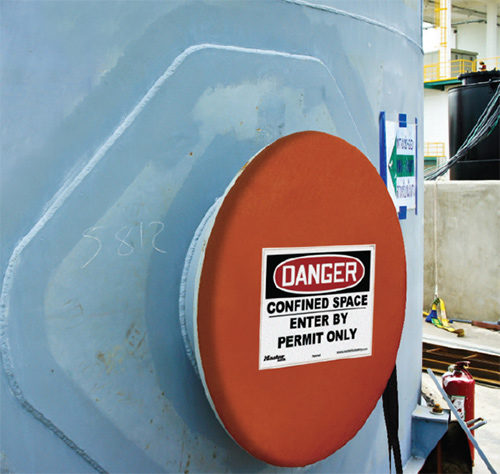Confined space hazards
When an area is identified as a confined space, what does an employer need to do about it?

Responding is Todd Grover, global senior manager – applied safety solutions, Master Lock Co. LLC, Milwaukee.
Confined spaces come in many shapes, sizes and configurations. Often, they are easy to spot. Sometimes they are not. Workers need to recognize that potentially hazardous areas in their facility exist and are big enough for people to enter, challenging to access and exit, and definitely not intended for people to routinely occupy. These areas clearly involve dangers that can be expected to cause problems for anyone trying to work within these spaces, such as atmospheric or chemical exposures, fall hazards, moving machinery, or electrical systems.
A sound confined space program begins with knowledgeable people taking a thorough look at the employer’s workplace and conservatively identifying every area or space that is big enough to get into, not easy to get into, and not intended as a designated workspace. Rather, the area has another purpose, such as housing equipment or storing product; shielding hazardous areas; or being a pathway for liquid, gases or solids to flow through.
Once all of these confined spaces are identified, the employer has the responsibility of clearly marking all associated entry points with signage that prohibits personnel from going into them without taking specific precautions and control measures. Securing the access points against unauthorized entry is also highly recommended by locking hatchways, bolting or welding covers in place, or securing obvious barrier protection over them.
Before work inside these potentially dangerous areas is authorized by the employer, a detailed hazard assessment needs to be performed for each identified confined space. If, after a thorough evaluation, some of these confined spaces are determined to have no possible dangers associated with work performed inside, entry restrictions can be removed and full access can be restored.
But this circumstance is uncommon. In most cases, dangers cannot be fully removed or work being done inside these areas introduces new hazards within the confined space. Routinely, the employer has an obligation to put into effect a full confined space entry program that requires permits to be issued to authorized personnel whenever entry must take place.
Employers must train their personnel to conduct confined space entry procedures or hire qualified contractors who can protect themselves with a permit entry system. This involves working from the guidance provided in the hazard assessments, continuously monitoring working conditions, and having all necessary safety equipment to prevent accidents from occurring. And if, despite the precautions, an accident does occur, employers must have in place an effective rescue capability to quickly get entrants out without jeopardizing the safety of participating rescuers.
Preventing these kinds of accidents starts with the identification and securing of all confined spaces and prohibiting unauthorized entry. Employers should be sure a complete hazard assessment is performed for each space on their premises and use the completed assessments to fully prepare their employees or contractors for safe entry operations.
Editor's note: This article represents the independent views of the author and should not be construed as a National Safety Council endorsement.
Post a comment to this article
Safety+Health welcomes comments that promote respectful dialogue. Please stay on topic. Comments that contain personal attacks, profanity or abusive language – or those aggressively promoting products or services – will be removed. We reserve the right to determine which comments violate our comment policy. (Anonymous comments are welcome; merely skip the “name” field in the comment box. An email address is required but will not be included with your comment.)

